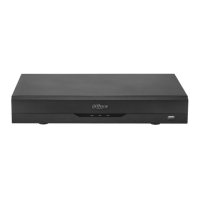
Do you have a question about the Dahua DH-XVR5104HS-4KL-I3 and is the answer not in the manual?
| Max Recording Resolution | 8MP |
|---|---|
| Power Consumption (Without HDD) | ≤ 10W |
| Operating Humidity | 10% to 90% |
| Smart Fan | Yes |
| Video Input | 4 Channels |
| Max Resolution | 8MP (3840x2160) |
| Compression | H.265+/H.265/H.264+/H.264 |
| Audio Input | 1 Channel |
| Audio Output | 1 channel, RCA |
| Storage | 1 SATA port, up to 10TB |
| Max IP Camera Input | 4 Channels |
| Video Output | HDMI, VGA |
| HDMI Output Resolution | 4K (3840x2160) |
| VGA Output Resolution | 1920 × 1080 |
| Network Interface | 1 RJ45 10M/100M/1000Mbps |
| USB Interface | 2 USB 2.0 |
| Power Supply | 12V DC |
| Operating Temperature | -10°C to +55°C (14°F to 131°F) |
Safety precautions for using the device.
Record of manual versions and changes.
Guidelines for proper installation and handling of the device.
Safety precautions related to power supply and electrical connections.
Overview of the digital video recorder and its capabilities.
Details on AI, Real-time Surveillance, IoT, and Sensor Integration functions.
Instructions to check package contents and device labels.
Guidance on installing an HDD, recommending official HDDs.
Description of the front panel components and their functions.
Description of the rear panel ports and their functionalities.
Details on how to perform operations using the mouse.
Illustrates typical connection diagrams for the device setup.
Guidance on connecting video and audio input/output devices.
Instructions for connecting alarm input and output ports.
Steps for initial setup, including booting and device initialization.
Viewing live video from connected cameras and understanding status icons.
Steps to access the main menu via the shortcut menu.
Configuring PTZ connection settings for local and remote control.
Adjusting image settings like saturation, brightness, and sharpness.
Adding remote devices by their IP address.
Enabling and configuring manual and automatic recording.
Configuring snapshot quantity, channel, size, and quality.
Searching and playing back recorded videos.
Configuring alarm settings for various event types.
AI module features including face detection, recognition, IVS, and video structuring.
Backing up recorded videos and snapshots to a USB storage device.
Configuring network settings for device interworking.
Adding, modifying, and deleting user accounts, groups, and ONVIF users.
Managing stored resources like recorded video files and storage space.
Setting security options to strengthen device security.
Configuring device basic, time, and holiday settings.
Viewing log information, HDD information, and version details.
Procedures for logging out, rebooting, or shutting down the device.
Steps for connecting the device to a network.
Steps for logging into the device via a web browser.
Troubleshooting steps for a DVR that fails to boot up correctly.
Troubleshooting login issues for client-end software and web interface.
Troubleshooting IP channel connection issues.
List of compatible USB storage devices.
List of compatible SATA HDDs.
Explanation of power surges and their effects on electronic devices.
Essential security actions like using strong passwords and updating firmware.
Recommended practices for enhancing device network security.











